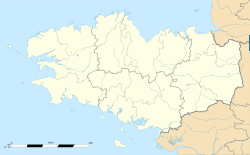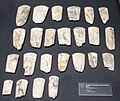Top Qs
Timeline
Chat
Perspective
Saint-Michel tumulus
Ancient grave mound in Brittany, France From Wikipedia, the free encyclopedia
Remove ads
The Saint-Michel tumulus (Breton: tumulus Sant-Mikael) is a megalithic grave mound, located east of Carnac in Brittany, France.[1] It is the largest grave mound in continental Europe.
You can help expand this article with text translated from the corresponding article in French. (October 2012) Click [show] for important translation instructions.
|
Remove ads
History

The tumulus was built during the fifth millennium BC. It consists of a mound of earth and stones 125 metres (410 ft) long, 50 metres (160 ft) wide and 10 metres (33 ft) high.[1] Explored in 1862, researchers found a central vault containing fairly prestigious funerary furniture: axes, pearls, flint tools, and sillimanite.
On 27 June 1795, the site served as the setting for the Battle of Saint-Michel Tumulus between the French and the British during the Great French War.
It has been classified as a "Monument historique" (National heritage site) since 1889.
Around 1900, the archaeologist Zacharie Le Rouzic again excavated the Saint-Michel tumulus and discovered a second dolmen and fifteen small stone chests, thus revealing the complexity of this monument.
Remove ads
Gallery
- Saint-Michel tumulus plan by Zacharie Le Rouzic
- Excavation entrance to the tumulus
- Finds from the Saint-Michel tumulus
- Jade axes from the tumulus
- Callais necklace from the tumulus
- Broken stone axes from the tumulus
References
Wikiwand - on
Seamless Wikipedia browsing. On steroids.
Remove ads













